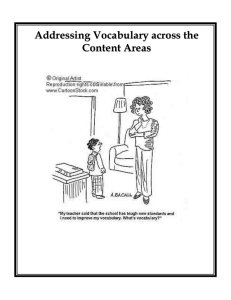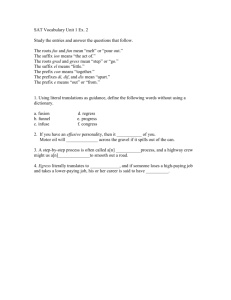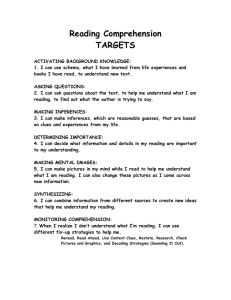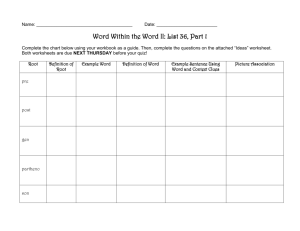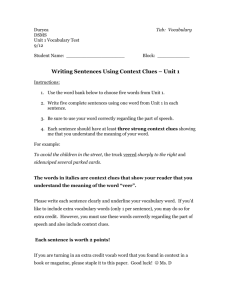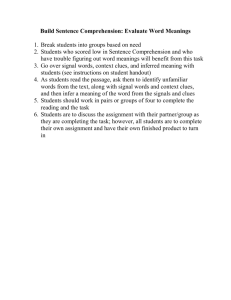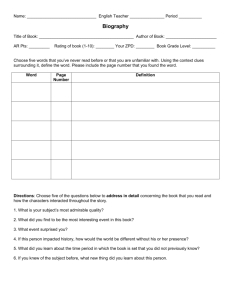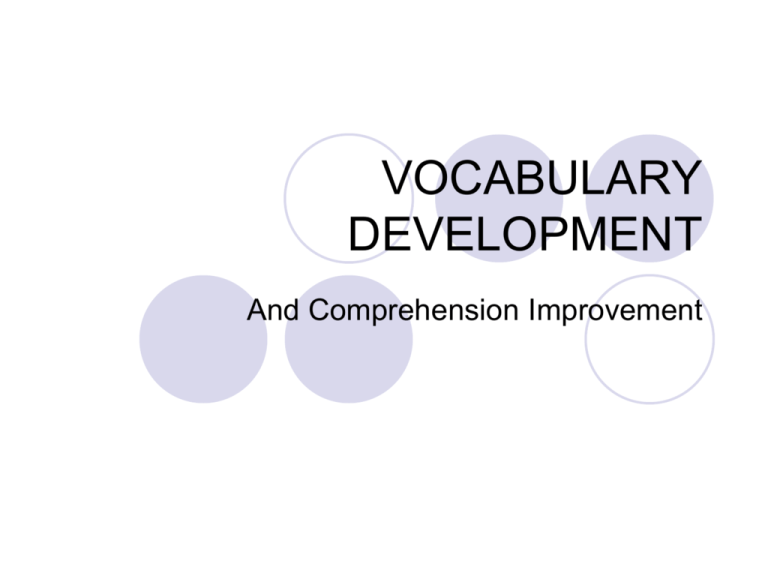
VOCABULARY
DEVELOPMENT
And Comprehension Improvement
Words as Tools
To access background knowledge
To express ideas
To learn about new concepts
Word knowledge is crucial to reading
comprehension and academic success.
Three Types of Vocabulary
Listening – Established by the time student
begins kindergarten
Speaking – Words used in everyday speech
Reading – Body of words students must know if
they are to read increasingly demanding text
with fluency and comprehension
On average, students add 2,000-3,000 words a year to
their reading vocabularies
Six to eight words per day
Two Vocabulary Dimensions
Breadth
The number of words that a student knows, at
least at a superficial level
Depth
How well the student knows a word, including
pronunciation, spelling, meaning, frequency,
and morphological and syntactic properties
Morphology – The formation, internal structure, and
derivations of words
Syntax – The arrangement of words within phrases,
clauses, and sentences
Breaking Down Types of Words
Tier One – In spoken vocabulary: mother, clock,
jump
Tier Two – Words with wide usage that most
readers do not have in their spoken
vocabularies: dismayed, paradoxical, absurd,
wary. Estimated 7,000 words
Tier Three – Highly specialized and are almost
never used outside of the disciplines where they
are encountered: monozygotic, tetrahedron,
bicameral
Strategies to Increase Vocabulary
Development
Implicit
Wide reading
Readers learn new words by repeatedly encountering them in text
Explicit
Instruction
Structural Analysis: The use of word parts
• Prefixes- word part added to beginning of a root or word: preheat
• Suffixes- word part added to the end of a word or root and usually
changes the word’s part of speech: cloud (n) Cloudy (adj)
• Roots-Word parts that carry the basic or core meaning of a word:
scrib/script = write scribble
• Compounds-A new word formed by two words: paperwork
Use of context clues
Efficient use of the dictionary
Structural Analysis
Many words in the English language are made
up of words parts called prefixes, roots, and
suffixes.
These word parts have specific meanings that,
when added together, can help you determine the
meaning of the entire word.
Example: The students thought the book was
incomprehensible.
• in = not
• Comprehen = to understand
• ible = able to do something; also changes this word from verb
to adjective
• incomprehensible = not able to understand
Structural Analysis
In most cases, a word is built upon at least one root.
Words can have more than one prefix, root, or suffix.
Two or more roots – geo/logy: earth/study of
Two prefixes – in/sub/ordination: not/under/order
Two suffixes – beauti/ful/ly: beauty/full of- noun to
adjective/ly- adjective to adverb
Words do not always have a prefix and a suffix.
Some words have neither a prefix or a suffix – read
Others have a suffix but no prefix – read/ing
Others have a prefix but no suffix – pre/read
Structural Analysis
•
The spelling of roots may change as they are combined with suffixes – Root: terr/terre = territory
•
Different prefixes, roots, or suffixes may have the same meaning:
bi-, di-, duo- all mean two
•
Sometimes you may identify a group of letters as a prefix or root but find that it does not carry the
meaning of that prefix or root:
Ex. The letters mis in the word missile are part of the root and are not the prefix mis- which means
“wrong; bad”
•
Websites that provide Prefix, Suffix, and Root Tables (meanings and examples)
http://www.msu.edu/~defores1/gre/roots/gre_rts_afx-tab1htm
http://www.msu.edu/~defores1/gre/sufx/gre_suffx_tab_prn.htm
Context Clues
The words around an unfamiliar word that
give you clues about the unknown word’s
meaning
The couple finally secured a table at the
popular, crowded restaurant.
By using the clues around the word secured,
the reader can determine that secured means
“able to get.”
Types of Context Clues – Definition or
Synonym
Sometimes a writer will provide a formal definition of the unknown word:
The settlers reached the piedmont, a gently rolling foothill area between a plain and mountains.
More often a writer will provide a synonym or a brief phrase that defines the unfamiliar word:
The king’s laws were often arbitrary; in other words, he made rules based on how he felt at the
moment.
Common signal words: which is, in other words, also known as, also called, that is, or
Common punctuation:
Commas –The amateur figure skater surpassed, or exceeded, the judges’ expectations.
Dashes – The sculptor usually created a maquette – a small model – before beginning work on
the actual piece.
Parentheses – Thick layers of loess (wind-blown silt) cover regions of the Mississippi River Valley.
These definitions or synonyms may not be found in the same sentence but elsewhere in
the text.
Types of Context Clues - Example
The context in which a word appears may include one or
more examples that are clues to the unknown word’s
meaning.
Our science class is studying crustaceans, such as
lobsters, shrimp, and crab.
Crustaceans must be sea animals with an exoskeleton
and segmented body parts.
Words signaling Example context clues:
like for example other including
for instance such as these include
Types of Context Clues - Comparison
The writer compares the unfamiliar word with more
familiar words. By noting the similarities between the
things described, the reader can get an idea of the
meaning of the word.
The amethyst, like other precious stones known for
hardness, cannot be cut with a knife or scratched by
glass.
An amethyst must be a valuable gem that has the
properties of a diamond.
Words Signaling a Comparison:
like
similar to
similarly resembling
likewise
related
in the same way
Types of Context Clues – Contrast or
Antonym
The writer states how the meaning of the unfamiliar word
is different or opposite from the clue.
Lincoln’s Gettysburg Address was concise, in sharp
contrast to the long-winded, two-hour speech that he
presented earlier.
A concise speech is opposite of a long speech, so
concise must mean brief or short.
Words Signaling a Contrast or Antonym
but
on the other hand
instead
differently on the contrary although
however
in contrast to
unlike
Types of Context Clues – Cause & Effect
The cause of an action or event may be stated using an
unfamiliar word. If the effect is stated in familiar terms, it
can help the reader understand the unknown word.
The weeds in the garden are so profuse, that I can no
longer see the flowers.
Cause-There are many weeds.
Effect-You can’t see the flowers.
Profuse must mean a large quantity.
Words Signaling Cause and Effect
because consequently that
so
since
therefore
as a result
Types of Context Clues – Infer from
General Context
Often the context clues are in the surrounding
sentences, and the reader must infer or make an
educated guess about the unknown word’s meaning. A
single piece of information several sentences away from
the unfamiliar word may be an important clue.
By the middle of the semester, Bob started to see the
fallacy in this thinking. Since he had done well in high
school without doing much reading or schoolwork, he
thought he could continue this routine in college. He now
realized he had been mistaken. He would have to work
to earn the grades.
Fallacy must mean to make an error in judgment.
No Context Clues?
Not all sentences or text contain context
clues. You will need to use other methods
to determine the word’s meaning.
Some suggestions:
Pronounce the word aloud. You may hear a word or
word part that you know or that you may recall, within
the unknown word
Carefully analyze the word’s parts.
Look up the word in the dictionary.
References
Baumann, J.F., & Kameenui, E.J. (1991). Research on vocabulary instruction: Ode
to Voltaire. In J. Flood, D. Lapp, & J. R. Squire (Eds.), Handbook of research
on teaching the English language arts (pp. 604-632). New York:Macmillan.
McWhorter, K. (2006). Guide to College Reading. New York: Pearson
Longman.
McWhorter, K. (2006). Vocabulary simplified: Strategies for building your college
vocabulary. New York: Pearson Longman.
Quian, D.D. (1998). Depth of vocabulary knowledge: Assessing its role in adults’
reading comprehension in English as a second language.Unpublished doctoral
dissertation, University of Toronto, Toronto, Ontario, Canada.
Quian, D. D. (1999). Assess the roles of depth and breadth of vocabulary knowledge
in reading comprehension. Canadian Modern Language Review, 56, 282-308.
Texas Education Agengy. 2003). Promoting vocabulary development:
Components of effective vocabulary instruction, Texas Reading Initiative,
Austin, TX, (No. GEO1 105 04).


